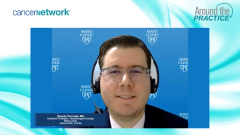
Goals of Treatment for Patients With Relapsed/Refractory Chronic Lymphocytic Leukemia (R/R CLL)
Medical expert discusses that when managing relapsed or refractory chronic lymphocytic leukemia, the goals are similar to first-line therapy, and he emphasizes using BCL-2 and BTK inhibitors, guided by factors such as previous therapies, patient preferences, and comorbidities.
Episodes in this series

Asher A. Chanan-Khan, MD, MBBS: Dr Parrondo, this patient and similar patients go from the first line, eventually get to relapse, or come in with relapsed or refractory [R/R] disease. I would like to hear your thoughts on what approach you take in the relapse setting. What are your goals, and how do you pick a therapy, especially if you have all these lists? How does the algorithm work when picking therapies for relapse or resistant therapy?
Ricardo Parrondo, MD: The goals of therapy for R/R CLL [chronic lymphocytic leukemia] are similar to first-line therapy. You want to alleviate constitutional symptoms, improve cytopenias, and alleviate bothersome splenomegaly and lymphadenopathy. You want to provide long-term disease control for the patient. And with all the available options, how do we sequence? We have several BTKis [Bruton tyrosine kinase inhibitors]. We have CD20 antibodies, BCL-2 inhibitors, and many emerging next-generation therapies, including noncovalent BTKis. There are PI3K [phosphoinositide 3-kinase] inhibitors. But my approach in the relapse setting is to stick with the most effective therapies, which are the BCL-2 and the BTKi. And the factors that guide, which of those to use, include what the previous therapy was. What was the response to the most recent therapy? Patient preferences again. Do they want all oral therapy? Do they want continuous vs time-limited therapy? What are the comorbidities of the patient? And do they have a TP53 mutation or not? So all those factors have to be taken into account when deciding on therapy for relapsed CLL. There’s no right or wrong answer. We know that you can use BCL-2; we have data. You can use a BCL-2 inhibitor after progression on a BTKi. We know that patients who got up-front venetoclax and obinutuzumab can be salvaged with a BTKi in the second-line setting, or you can rechallenge them with a venetoclax-based regimen. As I mentioned earlier, we have data for patients who got time-limited venetoclax; you can rechallenge them with a venetoclax-based regimen. So those are the factors that I take into account when deciding on therapy for relapsed CLL.
Newsletter
Stay up to date on recent advances in the multidisciplinary approach to cancer.









